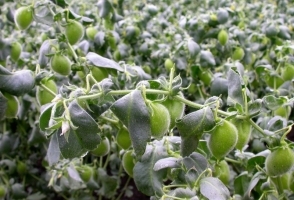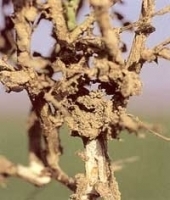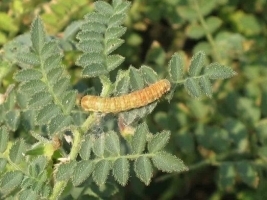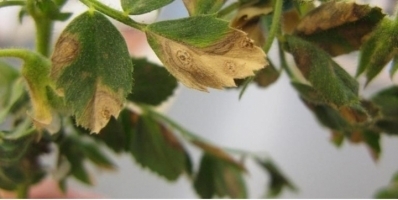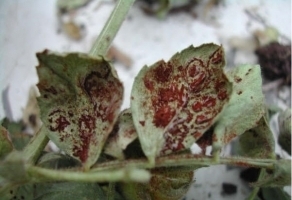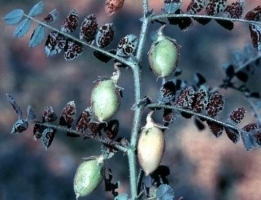Gram 1137: It is recommended for hilly areas. It gives an average yield of 4.5qtl/acre. It is resistant to virus.
PBG 7 : Recommended for cultivation in whole Punjab. This variety is moderately resistant to Ascochyta blight and resistant to wilt and dry root rot. Grain size is medium and gives average yield of 8 qtl/acre. It gets mature in 159 days.
CSJ 515: Suitable under irrigated condition, seeds are small and are of brown colour weight 17 gm/100 seed. It is moderately resistant to dry root rot, and tolerant to ascochyta blight. Gets mature in 135 days. And gives average yield of 7 qtl/acre.
BG 1053: It is a Kabuli variety. It is early in flowering and matures in 155 days. Seeds are creamy white and bold in size. Gives Average yield of 8 qtl/acre. Suitable for cultivation for throughout state under irrigated condition.
L 550: Kabuli variety. Semi spreading and early flowering variety. Matures in 160 days. Seeds are of creamy white color. It gives average yield of 6 qtl/acre.
L 551: It is kabuli variety. It is resistant to wilt disease. Ready to harvest in 135-140 days. It gives average yield of 6-8 qtl/acre.
GNG 1958: Cultivated under irrigated areas also suitable for normal sown irrigated condition. It has brown seed colour. Ready to harvest in 145 days. Gives average yield of 8-10 qtl/acre.
GNG 1969: Cultivated under irrigated areas also suitable for normal sown irrigated condition. It possess creamy beige seed colour. Ready to harvest in 146 days. Gives average yield of 9 qtl/acre.
GLK 28127: Suitable for cultivation under irrigated areas, seeds are of large size with light yellow or creamy colour with irregular owl head. Ready to harvest in 149 days. Gives average yield of 8 qtl/acre.
GPF2: The plants are tall with erect growth habit. It is highly resistive to Ascochyta blight and will complex. It gets matures in about 165 days. It gives average yield of 7.6 qtl/acre.
Aadhar (RSG-963): It is moderately resistant to Wilt, dry root rot, B.G.M and Collor rot, pod borer, & Nematodes. Ready to harvest in 125-130 days. Gives average yield of 6 qtl/acre.
Anubhav (RSG 888): Suitable for cultivation in rainfed area. It is moderately resistant to wilt and root rot. Ready to harvest in 130-135 days. Gives average yield of 9 qtl/acre.
Pusa Chamatkar: Kabuli variety. It is tolerant to wilt. Ready to harvest in 140-150 days. It gives average yield of 7.5 qtl/acre.
PBG 5: Released in 2003. The variety matures in 165 days and it gives an average yield of 6.8qtl/acre. It has medium thick grains and dark brown in color. The variety is tolerant to wilt and root diseases.
PDG 4: Released in 2000. The variety matures in 7.8qtl/acre and it gives an average yield of 160 days. The variety is tolerant to damping off, root rot and wilt disease.
PDG 3: It gives an average yield of 7.2qtl/acre and the variety matures in 160 days.
L 552: Released in 2011. The variety matures in 157 days and it gives an average yield of 7.3qtl/acre. It has thick grains and the average weight of 100 grains is 33.6gm.
Other States Variety
C 235: Ready to harvest in 145-150 days. It is tolerant to stem rot and blight disease. Grains are of medium and yellowish brown color. Gives average yield of 8.4-10 qtl/acre.
G 24: Semi-spreading variety, suitable for rainfed conditions. Ready to harvest in 140-145 days. Gives average yield of 10-12 qtl/acre.
G 130: Medium duration variety. Gives average yield of 8-12 qtl/acre.
Pant G 114: Ready to harvest in 150 days. It is resistant to blight. It give average yield of 12-14 qtl/acre.
C 104: Kabuli gram varieties, Suitable for Punjab and Uttar Pradesh. Gives average yield of 6-8 qtl/acre.
Pusa 209: Ready to harvest in 140-165 days. Gives average yield of 10-12 qtl/acre.

